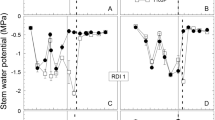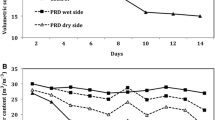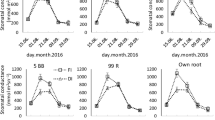Abstract
The effects of regulated deficit irrigation (RDI) and partial root-zone irrigation (PRI) strategies that apply the same irrigation volumes on vegetative and reproductive development were analyzed during a 3-year-period in field-grown Monastrell grapevines under semiarid conditions. Five treatments were applied: control irrigated at 60 % ETc (crop evapotranspiration) for the whole season (308 mm year−1); RDI-1 and PRI-1 that received the same irrigation as the control before fruit set, 30 % ETc from fruit set to harvest and 45 % ETc post-harvest (192 mm year−1); and RDI-2 and PRI-2 that were the same, except with 15 % ETc from fruit set to harvest (142 mm year−1). Distinctive PRI effects on vegetative and reproductive development were observed depending on the total soil water content and the vine water stress level. PRI-1 vines showed less restriction of vegetative growth, lower leaf abscission, and higher leaf area during post-veraison than RDI-1 vines. Higher supply of water (close to field capacity) via half of the root system in PRI-1 vines maintained better water supply and more favorable phloem sap flow (water and carbohydrates) into the fruit during post-veraison and showed a positive differential effect on fruit growth compared with RDI-1 vines. This was reflected in a higher solute content per berry (12 % higher) and higher fresh berry weight (8 % higher) at harvest in PRI-1 compared to RDI-1 berries. However, this positive effect in fruit growth was not reflected in either an improved final yield or the water use efficiency of PRI-1 vines. In PRI-2, the soil water in the wet half was insufficient to maintain more favorable shoot water supply and phloem sap flow into the berry, and no substantial changes were observed in vine vigor, leaf and fruit growth between PRI-2 and RDI-2. Higher irrigation amount in the wet root zone and higher depth of irrigation under PRI seem to be more effective for 1103P–Mourvedre combination to produce a favorable effect in berry growth and development.







Similar content being viewed by others
References
Allen RG, Pereira LS, Raesk D, Smith M (1998) Crop evapotranspiration-guidelines for computing crop water requirements. Irrigation and drainage paper No. 56. FAO, Rome, Italy
Alsina MM, Smart DR, Bauerle T, de Herralde F, Biel C, Stockert C, Negron C, Save R (2011) Seasonal changes of whole root system conductance by a drought-tolerant grape root system. J Exp Bot 62:99–109
Antolín MC, Ayari M, Sánchez diaz M (2006) Effects of partial root–zone drying on yield, ripening and berry ABA in potted Tempranillo grapevines with split roots. Aust J Grape Wine Res 12:13–20
Bindon K, Dry P, Loveys B (2008) Influence of partial root-zone drying on the composition and accumulation of anthocyanins in grape berries (Vitis vinifera cv. Cabernet Sauvignon). Aust J Grape Wine Res 14:91–103
Bravdo B, Hepner C, Loinger C, Cohen S, Tabacman H (1985) Effect of irrigation and crop level on growth, yield and wine quality of Cabernet Sauvignon. Am J Enol Vitic 36:132–139
Bravdo B, Naor A, Zahavi T, Gal Y (2004) The effects of water stress applied alternatively to part of the wetting zone along the season (PRD-partial rootzone drying) on wine quality, yield, and water relations of reed wine grapes. Acta Hortic 664:101–109
Castellarin SD, Matthews MA, Di Gaspero GD, Gambetta GA (2007a) Water deficits accelerate ripening and induce changes in gene expression regulating flavonoid biosynthesis in grape berries. Planta 227:101–112
Castellarin SD, Pfeiffer A, Sivilotti P, Degan M, Peterlunger E, Di Gaspero G (2007b) Transcriptional regulation of anthocyanin biosynthesis in ripening fruits of grapevine under seasonal water deficit. Plant Cell Environ 30:1381–1399
Chaves MM, Santos TP, Souza CR, Ortuño MF, Rodrigues ML, Lopes CM, Maroco JP, Pereira JS (2007) Deficit irrigation in grapevine improves water-use efficiency while controlling vigor and production quality. Ann Appl Biol 150:237–252
Chaves MM, Zarrouk O, Francisco R, Costa JM, Santos T, Regalado AP, Rodrigues ML, Lopes CM (2010) Grapevine under deficit irrigation: hints from physiological and molecular data. Ann Bot 105:661–676
Collins MJ, Fuentes S, Barlow EWR (2010) Partial root zone drying and deficit irrigation increase stomatal sensitivity to vapor pressure deficit in anisohydric grapevines. Funct Plant Biol 37:128–138
Davies WJ, Hartung W (2004) Has extrapolation from biochemistry to crop worked to sustain plant production under water scarcity? In: Proceeding of the 4th international crop science congress, Brisbane, Australia, published on CDROM, Published on CDROM, http://www.cropscience.org.au/icsc2004/
Davies WJ, Zhang J (1991) Root signals and the regulation of growth and development of plants in drying soil. Ann Rev Plant Physiol Plant Mol Biol 42:55–76
Davies WJ, Bacon MA, Thompson DS, Sobeith W, Gonzalez Rodrigues L (2000) Regulation of leaf and fruit growth in plants growing in drying soil: exploitation of the plant′s chemical signaling system and hydraulic architecture to increase the efficiency of water use in agriculture. J Exp Bot 51:1617–1626
Davies WJ, Kudoyarova G, Hartung W (2005) Long-distance of ABA signaling and its relation to other signalling pathways in the detection of soil drying and the mediation of the plant′s response to drought. J Plant Growth Regul 24:285–295
De la Hera ML, Romero P, Gomez-Plaza E, Martinez A (2007) Is partial root-zone drying an effective irrigation technique to improve water use efficiency and fruit quality in field-grown wine grapes under semiarid conditions? Agric Water Manag 87:261–274
De Pau L, Satta D, Zucca L, Bandino G, Mameli MG (2011) Effects of the irrigation regime and partial root zone drying in Vermentino grapevines in Sardinia, Italy. Acta Hort 889:83–90
Dodd IC, Egea G, Davies WJ (2008) Accounting for sap flow from different parts of the root system improves the prediction of xylem ABA concentration in plants grown with heterogeneous soil moisture. J Exp Bot 59:4083–4093
Dry PR (2005) Use of irrigation strategies for maximization of water use efficiency and wine quality in Australia. In: International symposium on irrigation management in wine and table grape vineyards. Santiago, Chile: INIA
Dry PR, Loveys BR (1998) Factors influencing grapevine vigor and the potential for control with partial root-zone drying. Aust J Grape Wine Res 4:140–148
Dry PR, Loveys BR (1999) Grapevine shoot growth and stomatal conductance are reduced when part of the root system is dried. Vitis 38:151–156
Dry PR, Loveys BR, Botting D, During H (1996) Effect of partial root-zone drying on grapevine vigour, yield, composition of fruit and use of water. In: Proceedings of the 9th Australian wine industry technical conference, pp 126–131
Dry PR, Loveys BR, During H (2000a) Partial drying of the root zone of grape. I. Transient changes in shoot growth and gas exchange. Vitis 39:3–7
Dry PR, Loveys BR, Stoll M, Steward D, McCarthy MG (2000b) Partial root zone drying-an update. The austral grapegrower winemaker. Annual technical issue, pp 35–39
Dry PR, Loveys BR, McCarthy MG, Stoll M (2001) Strategic management in Australian vineyards. J Internac Sci Vig Vine 35:129–139
Du T, Kang S, Zhang J, Li F, Yan B (2008) Water use efficiency and fruit quality of table grape under alternate partial root-zone drip irrigation. Agric Water Manag 95:659–668
Du toit G, Dry P, Loveys B (2003) A preliminary investigation on partial root-zone drying (PRD) effects on grapevine performance, nitrogen assimilation and berry composition. South Afr J Enol Vitic 24:43–54
Garcia Garcia J, Martinez-Cutillas A, Romero P (2012) Financial analysis of wine grape production using regulated deficit irrigation and partial root-zone drying strategies. Irrig Sci 30:179–188
Girona J, Mata M, del Campo J, Arbones A, Bartra E, Marsal J (2006) The use of midday leaf water potential for scheduling deficit irrigation in vineyards. Irrig Sci 24:115–127
Gowing DJ, Davies WJ, Jones HG (1990) A positive root-source signal as an indicator of soil drying in apple, Malus domestica Borkh. J Exp Bot 41:1535–1540
Greenspan MD, Shackel KD, Matthews MA (1994) Developmental changes in the diurnal water budget of the grape berry exposed to water deficits. Plant Cell Environ 17:811–820
Greenspan MD, Schultz HR, Matthews MA (1996) Field evaluation of water transport in grape berries during water deficits. Physiol Plant 97:55–62
Gu S, Guoqiang D, Zoldoske D, Hakim A, Cochran R, Fugelsang K, Jorgensen G (2004) Effects of irrigation amount on water relations, vegetative growth, yield and fruit composition of Sauvignon blanc grapevines under partial root-zone drying and conventional irrigation in the San Joaquin Valley of California, USA. J Hort Sci Biotech 79:26–33
Intrigliolo DS, Castel JR (2009) Response of Vitis vinifera cv. “Tempranillo” to partial root-zone drying in the field: water relations, growth, yield and fruit and wine quality. Agric Water Manag 96:282–292
Kliewer WM, Dokoozlian NK (2005) Leaf area/crop weight ratios of grapevines: influence on fruit composition and wine quality. Am J Enol Vitic 56:170–181
Li B, Feng Z, Xie M, Sun M, Zhao Y, Liang L, Liu G, Zhang J, Jia W (2011) Modulation of the root-sourced ABA signal along its way to the shoot in Vitis riparia x Vitis Labrusca under water deficit. J Exp Bot 62:1731–1741
Liu F, Jensen CR, Andersen MN (2005) A review of drought adaptation in crop plants: changes in vegetative and reproductive physiology induced by ABA-based chemical signals. Austr J Agr Res 56:1245–1252
Loveys BR (1999) Grapevine shoot growth and stomatal conductance are reduced when part of the root system is dried. Vitis 39:151–156
Marsal J, Mata M, Del Campo J, Arbonés A, Vallverdú X, Girona J, Olivo N (2008) Evaluation of partial root-zone drying for potential field use as a deficit irrigation technique in commercial vineyards according to two different pipeline layouts. Irrig Sci 26:347–356
McCarthy MG, Coombe BG (1999) Is weight loss in ripening grape berries cv. Shiraz caused by impeded phloem transport? Aust J Grape Wine Res 5:17–21
McCarthy MG, Loveys BR, Dry PR, Stoll M (2002) Regulated deficit irrigation and partial root zone drying as irrigation management techniques for grapevines. Deficit irrigation practices, FAO Water Reports No. 22. Rome, Italy
Mingo DM, Bacon MA, Davies WJ (2003) Non-hydraulic regulation of fruit growth in tomato plants (Lycopersicum sculetum cv. Solairo) growing in drying soil. J Exp Bot 54:1205–1212
Mitchell PD, Chalmers DJ (1982) The effect of reduced water supply on peach tree growth and yields. J Am Soc Hort Sci 10:853–856
Poni S, Bernizzoni F, Civardi S (2007) Response of “Sangiovese” grapevines to partial root-zone drying: gas-exchange, growth and grape composition. Sci Hortic 114:96–103
Roby G, Matthews MA (2004) Relative proportions of seed, skin and flesh in ripe berries from Cabernet Sauvignon grapevines grown in a vineyard either well irrigated or under water deficit. Aust J Grape Wine Res 10:74–82
Rodrigues MC, Santos TP, Rodrigues A, de Souza CR, Lopes CM, Maroco JP, Pereira JS, Chaves MM (2008) Hydraulic and Chemicals signalling in the regulation of stomatal conductance and plant water use in field grapevines growing under deficit irrigation. Funct Plant Biol 35:565–579
Romero P, Fernández-Fernández JI, Martinez-Cutillas A (2010) Physiological thresholds for efficient regulated deficit-irrigation management in wine grapes grown under semiarid conditions. Am J Enol Vitic 61:300–312
Romero P, Dodd IC, Martinez-Cutiillas A (2012) Contrasting physiological effects of partial root zone drying in field-grown grapevine (Vitis vinifera L cv. Monastrell) according to total soil water availability. J Exp Bot. doi:10.1093/jxb/ers088
Rose S, Groves S, Bailey R (2001) Calibration of a capacitance sensor for soil water measurement. UK Irrig 29:17–19
Sadras VO (2009) Does partial root-zone drying improve irrigation improve irrigation water productivity in the field? A meta-analysis. Irrig Sci 27:183–190
Santos T, Lopes CM, Rodrigues ML, Souza CR, Maroco JP, Pereira JS, Silva JR, Chaves MM (2003) Partial rootzone drying: effects on growth, and fruit quality of field grown grapevines (Vitis vinifera L.). Funct Plant Biol 30:663–671
Santos TP, Lopes CM, Rodrigues ML, de Souza CR, Ricardo-Da-Silva JM, Maroco JP, Pereira JS, Chaves MM (2005) Effects of partial root-zone drying irrigation on cluster microclimate and fruit composition of field grown Castelao grapevines. Vitis 44:117–125
Santos TP, Lopes CM, Rodrigues ML, de Souza CR, Ricardo-da-Silva JM, Maroco JP, Pereira JS, Chaves MM (2007) Effects of deficit irrigation strategies on cluster microclimate for improving fruit composition of Moscatel field-grown grapevines. Sci Hort 112:321–330
Sepaskhah AR, Ahmadi SH (2010) A review on partial root-zone drying irrigation. Int J Plant Prod 4:241–258
Sharp RE (2002) Interaction with ethylene: changing views on the role of abscisic acid in root and shoot growth responses to water stress. Plant Cell Environ 25:211–222
Sharp RE, LeNoble ME, Else MA, Thorne ET, Gherardi F (2000) Endogenous ABA maintains shoot growth in tomato independently of effects on plant water balance: evidence for an interaction with ethylene. J Exp Bot 51:1575–1584
Shellie KC (2006) Vine and berry response of merlot (Vitis vinifera L.) to differential water stress. Am J Enol Vitic 57:514–518
Souza CR, Maroco JP, Dos Santos TP, Rodrigues ML, Lopes CM, Pereira JS, Chaves MM (2003) Partial rootzone drying: regulation of stomatal aperture and carbon assimilation in field-grown grapevines (Vitis vinifera cv. Moscatel). Func Plant Biol 30:653–662
Srinivasan C, Mullins MG (1981) Physiology of flowering in the grapevine. A review. Am J Enol Vitic 32:47–63
Stoll M, Loveys B, Dry P (2000) Hormonal changes induced by partial root-zone drying of irrigated grapevine. J Exp Bot 51:1627–1634
Tattini M, Gucci R, Romani A, Baldi A, Everard JD (1995) Growth, gas exchange and ion content in Olea europaea plants during salinity and subsequent relief. Physiol Plant 95:203–210
Wang J, Kang S, Li F, Zhang F, Zhang J (2008) Effects of alternate partial root-zone drying on soil microorganism and maize growth. Plant Soil 302:45–52
Yang JC, Zhang JH, Wang ZQ, Zhu QS (2003) Hormones in the grains in relation to sink strength and post-anthesis development of spikelets in rice. Plant Growth Regul 41:185–195
Acknowledgments
This work was financed by the Instituto Nacional de Investigación y tecnología Agraria y Alimentaria (INIA), Subprograma Nacional de Recursos y Tecnologías Agrarias through the Projects RTA2005-00103-00-00 and RTA2008-00037-C04-04 with the collaboration of The European Social Fund. Pascual Romero-Azorin gratefully acknowledges a doctoral contract in the INIA-CCAA system supplied by the Instituto Nacional de Investigación y Tecnología Agraria y Alimentaria (INIA) and co-financed by The European Social Fund. We thank Atanasio Molina Molina, Aniceto Turpín Bermejo, Antonio Lucas Bermudez, and Cristobal Marín for their cooperation with vineyard management, Juan Jose Sánchez Ruiz and Jose María Rodriguez de Vera-Beltrí for their field assistance and support with laboratory analyses.
Author information
Authors and Affiliations
Corresponding author
Additional information
Communicated by S. Ortega-Farias.
Electronic supplementary material
Below is the link to the electronic supplementary material.
Rights and permissions
About this article
Cite this article
Romero, P., Martinez-Cutillas, A. The effects of partial root-zone irrigation and regulated deficit irrigation on the vegetative and reproductive development of field-grown Monastrell grapevines. Irrig Sci 30, 377–396 (2012). https://doi.org/10.1007/s00271-012-0347-z
Received:
Accepted:
Published:
Issue Date:
DOI: https://doi.org/10.1007/s00271-012-0347-z




